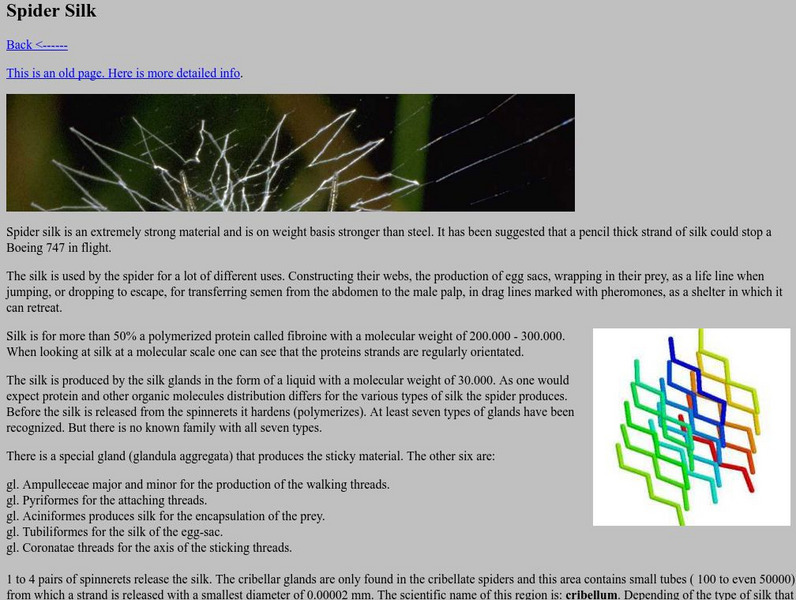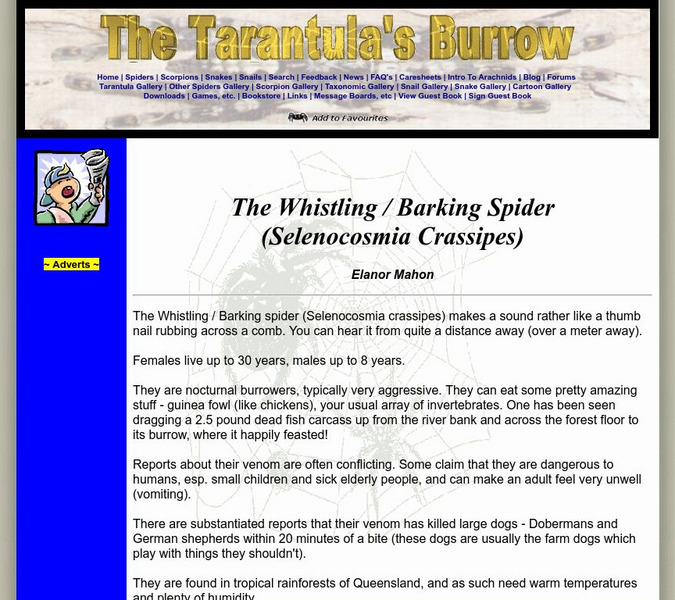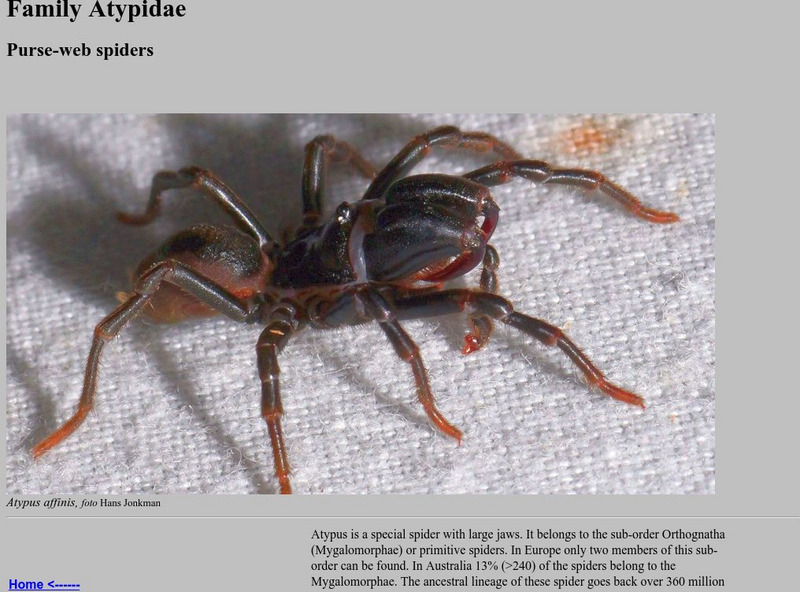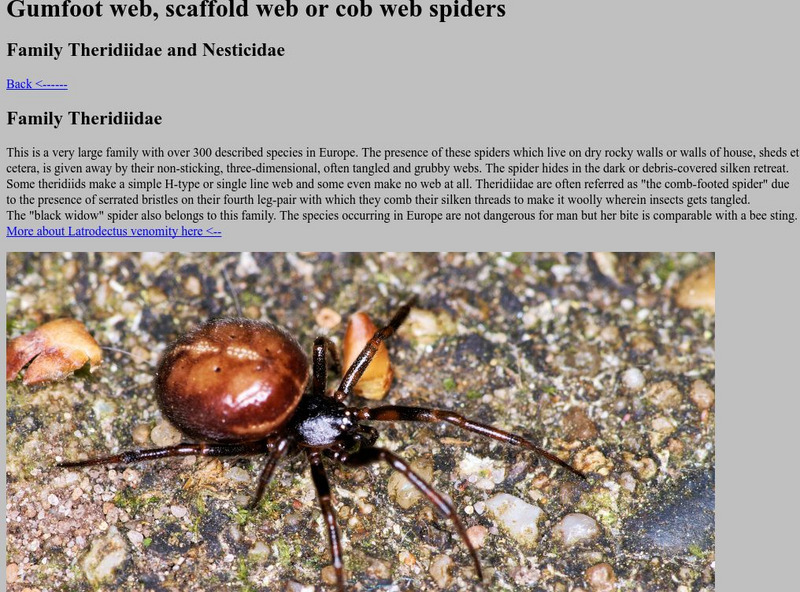Hi, what do you want to do?
BiologyWise
Biology Wise: A Detailed Description of the Anatomy of Spiders
Describes anatomical features of a spider, including its external structure, eyes, mouth parts, digestive system, circulatory system, respiratory system, nervous system, reproductive system, and its spinnerets.
Burke Museum
Burke Museum: Spider Identification
As part of the Arachnology section of the Burke Museum, this site corrects false conceptions associated with identifying spiders.
American Museum of Natural History
American Museum of Natural History: White Tailed Spider O Logy Card
Turn over this interactive card and start learning bite-size pieces of useful information about the white-tailed spider, such as their diet and physical characteristics.
Other
Harry's Big Adventure: Lesson Plans: Spider and Insect Detectives
Lesson plans that include group activities and handouts to introduce students to the differences between spiders and insects.
Other
The Water Spider
A resource with information on the water spider. Contains pictures and information on the way the spider stays alive and how it feeds.
Other
Tarantula's Burrow: British Spiders What Is a Spider?
A list of characteristics that a creature must satisfy to be considered a spider, as well as a list with pictures and descriptions of spiders commonly found in the UK.
University of Kentucky
University of Kentucky: Common Spiders
Find concise information that chronicles common spiders found around homes and buildings. Several descriptions and pictures are included on this site.
BBC
Bbc Nature: Camel Spiders
Camel spiders have a nightmarish reputation. Urban legends, fueled by the appearance of their extra large, powerful mouthparts, their voracious appetite, and their tremendous speed, surround these hairy arachnids. Learn more about camel...
University of Kentucky
University of Kentucky: Brown Recluse Spider
Webpage reference on the brown recluse spider which is more poisonous than a black widow and is more often found infesting homes and businesses.
Other
Ed Nieuwenhuys' Spiders & Immunology: Spider Silk
An informative site on the properties of spider silk, including its surprising strength and how it's produced.
Other
Araneae, Spiders of Europe: Family Amaurobiidae
Multiple colorful pictures bring this web site to life. Contains information on the mating and preying habits of the amaurobiidae, otherwise known as the tunnel weavers.
Other
The Tarantula's Burrow: The Whistling / Barking Spider
A quick overview on the whistling spider which is found predominantly in Australia. Includes reports on their ability to make noise and the effects of their bites.
PBS
Pbs Teachers: Scientific American: Spiders! Spin, Spin, Spin
Investigate the use of computers to simulate spider behaviors to learn more about how and why spiders build webs. Build a model of a web to compare your eyesight and dexterity to a spider's, then compare the elasticity and strength of...
PBS
Pbs Teachers: Scientific American: Spiders! Song and Dance
Explore the diversity and prevalence of spiders around the world, and learn about jumping spiders, hunters that stalk their prey and pounce from a distance. Research the types and population density of spiders that live around you.
Other
The Anatomy of a Spider
A comprehensive site on the anatomy of a spider, complete with diagrams, pictures, and detailed descriptions.
Sheppard Software
Sheppard Software: Daddy Long Legs
Find out the difference between harvestmen and spiders in the arachnid family. Read about the diet, characteristics, and status as an endangered species.
Burke Museum
Burke Museum: Arachnology
Arachnology, or the study of spiders and other Arachnida, is discussed here in the research and collection section of the Burke Museum. Other topics discussed include spider myths, research, and people.
Other
Araneae, Spiders of North West Europe: Purse Web Spiders
A detailed description of the primitive purse-web spider. Includes pictures and information on how it catches its prey
Other
Araneae, Spiders of North West Europe: The Black Widow
This site contains information on the black widow's family. Includes information and pictures on the entire family, not just the black widow.
Other
Tb: Spiders Considered as Medically Important
This article investigates how humans vary in their vulnerability to venomous spiders and the importance of certain spiders to medical research. It investigates what factors contribute to this difference.
PBS
Pbs Teachers: Scientific American: Spiders! Spider Canyon
Investigate funnel-web spiders and their ability to adapt in order to survive. Make a set of spider trading cards that will include information about a spider's behavior, habitat and adaptations.
PBS
Pbs Teachers: Scientific American: Spiders! Amazon Tales
Explore several spider species and learn about their adaptations to the world around them. Design a new species of spider, with adaptations required to survive in a particular habitat.
Oakland Zoo
Oakland Zoo: Brazilian Black Tarantula
Meet the Brazilian black tarantula and discover fascinating facts and statistics. Learn about its physical characteristics, habitat, diet, behavior, breeding patterns, and more.
Curated OER
Kids Health: Hey! A Black Widow Spider Bit Me
This site is provided for by KidsHealth. Black widow spiders are poisonous spiders. Use this site to find out how to identify them, where they live, and what to do if you are bitten by one.

























